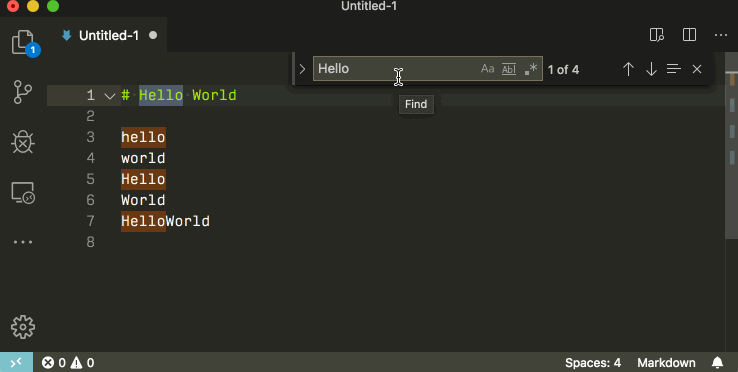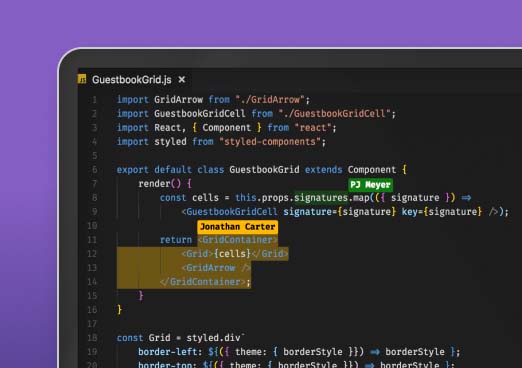

- #COMMENT THE CODE IN VISUAL STUDIO CODE FOR MAC HOW TO#
- #COMMENT THE CODE IN VISUAL STUDIO CODE FOR MAC INSTALL#
- #COMMENT THE CODE IN VISUAL STUDIO CODE FOR MAC FULL#
- #COMMENT THE CODE IN VISUAL STUDIO CODE FOR MAC SOFTWARE#
On Linux, install Avahi using the command sudo apt-get install avahi-daemon.
#COMMENT THE CODE IN VISUAL STUDIO CODE FOR MAC SOFTWARE#
If it doesn’t work for you then you can install additional software locally to add support. local syntax is supported on macOS and the latest versions of Windows or Linux. local, so if you are using the default hostname of raspberrypi, enter raspberrypi.local. For the host, enter the IP address of the Raspberry Pi, or the hostname. Search for and select Remote SSH: Connect current window to host (there’s also a connect to host option that will create a new window).Įnter the SSH connection details, using For the user, enter the Raspberry Pi username (the default is pi). Launch the VS Code command palette using Ctrl+Shift+P on Linux or Windows, or Cmd+Shift+P on macOS. Next you can connect to your Raspberry Pi. Select the Remote Development extension, and select the Install button. Select the Extensions tab from the sidebar menu, then search for Remote development. If not, you can install it from the VS Code downloads page.įrom inside VS Code, you will need to install the Remote SSH extension. Once the Raspberry Pi is set up, you can connect from VS Code on your Mac or PC.įirst make sure you have VS Code installed.
#COMMENT THE CODE IN VISUAL STUDIO CODE FOR MAC HOW TO#
If you don’t know how to do this, it is also covered in the Raspberry Pi documentation. You also need to know either the IP address of the Raspberry Pi, or its hostname. The Raspberry Pi documentation has a great article on setting up a headless Raspberry Pi if you don’t already know how to do this. Set up remote development on Raspberry Piįor remote development, your Raspberry Pi needs to be connected to your network either by ethernet or WiFi, and have SSH enabled. It is not supported on older Raspberry Pis, or on Raspberry Pi Zero. I can access the Raspberry Pi file system, run commands on a terminal connected to it, access whatever hardware my Raspberry Pi has, and debug on it. When you are debugging, the debug session runs on the remote device, but VS Code runs on the host machine.įor example – I can run VS Code on my MacBook Pro, and connect remotely to a Raspberry Pi 4 that is running headless. You see the remote file system, the VS Code terminal runs on the remote device, and you access the remote device’s hardware. This extension allows you to connect to a remote device over SSH, and run VS Code as if you were running on that remote device.

One of the extensions that helps here is the Remote SSH extension, part of a pack of remote development extensions. You can run VS Code on Windows, macOS, and of course on a Raspberry Pi. I practically live day to day in VS Code: whether I’m writing blog posts, documentation or Python code, or programming microcontrollers, it’s my work ‘home’.


There is a better way – using Visual Studio Code remote development! Visual Studio Code, or VS Code, is a free, open source, developer’s text editor with a whole swathe of extensions to support you coding in multiple languages, and provide tools to support your development.
#COMMENT THE CODE IN VISUAL STUDIO CODE FOR MAC FULL#
The downside is programming and debugging it – do you plug your Raspberry Pi into a monitor and run the full Raspberry Pi OS desktop, or do you use Raspberry Pi OS Lite and try to program and debug over SSH using the command line? Or is there a better way? Remote development with VS Code to the rescue The upside of headless is that my Raspberry Pi can be anywhere, not tied to a monitor, keyboard and mouse. Like a lot of Raspberry Pi users, I like to run my Raspberry Pi as a ‘headless’ device to control various electronics – such as a busy light to let my family know I’m in meetings, or my IoT powered ugly sweater. Jim Bennett from Microsoft, who showed you all how to get Visual Studio Code up and running on Raspberry Pi last week, is back to explain how to use VS Code for remote development on a headless Raspberry Pi.


 0 kommentar(er)
0 kommentar(er)
